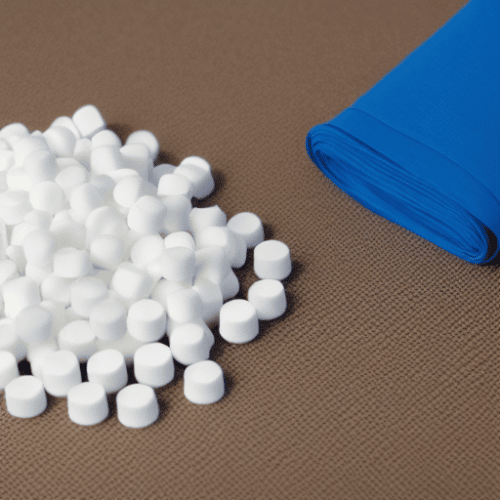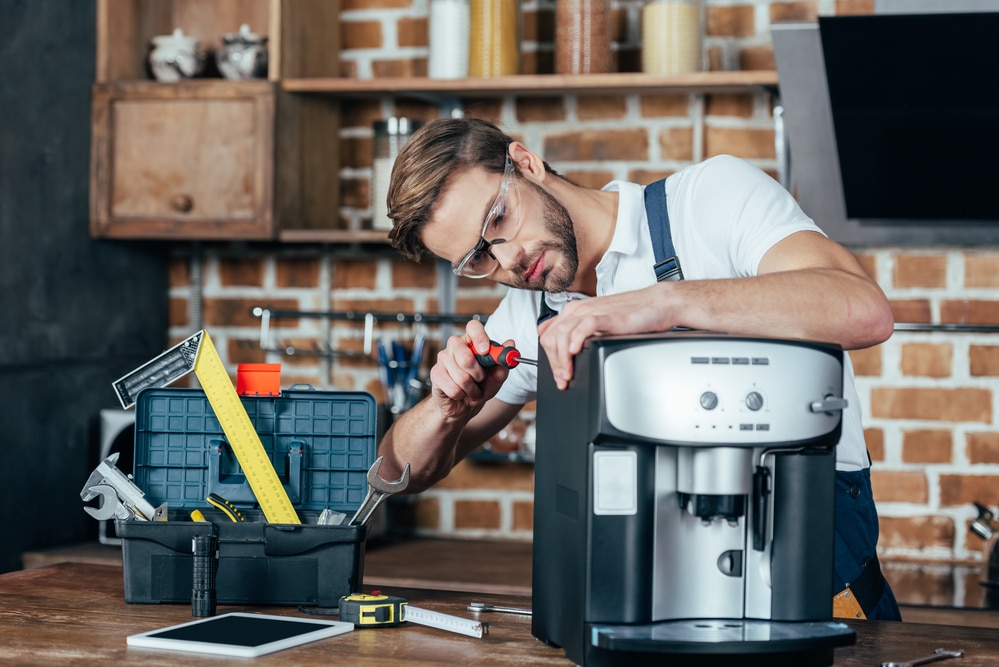Last Updated on
Learning how to descale a coffee pod machine is an important part of regular device maintenance. The more you clean your coffee machine, get rid of unwanted dirt, and remove limescale, the longer your investment will last.
Now that many people are using their coffee machines daily, it’s become increasingly essential for every homeowner to have a basic knowledge of how to preserve and care for these devices. When you descale your coffee machine, you ensure it can last as long as possible, but you also improve the flavour and quality of the drinks you make.
Descaling a Nespresso machine or similar coffee pod machine is a little different from descaling a kettle. However, with a few quick tips, you should manage this process with no problem. Today, we’re going to walk you through the steps of proper coffee machine descaling.
Why Should You Descale Your Coffee Machine?
Like kettles and other water tank devices exposed to regular hot water, coffee machines need regular descaling to work at their best. A dirty coffee machine adds contaminants to your drinks that can often ruin the taste. When you descale your device and go through a thorough machine cleaning process, you ensure you get the best cup of coffee.
Hot water boiling in a coffee machine’s water tank often leads to the build-up of various substances, including limescale and mineral deposits. If you have hard water in your home with more minerals, you may need to clean your coffee machine more regularly than if you live in a soft water area.
If you begin to notice an odd taste in your coffee, or you find that your product isn’t efficient as it used to be, then this could be a sign that it’s time to clean your device.
How Do I Descale My Nespresso Machine?
Most coffee pod machines and Nespresso machine devices have similar descaling processes. Generally, you’ll need to clean limescale from the container once every three months, but you might need to clean more regularly if you use your coffee machines every day.
Step 1: Get Everything Ready
Before you start cleaning, take some time to read through the instructions that came with your capsule coffee maker. The instructions should come with some basic information about descaling modes, what kind of descaler you need to use, and how often you should change your filter.
Before you begin, remove all capsules from the pod container system, so you’re not going to damage them. Empty the drip tray and grab a cloth so you can give the machine a quick clean-over.
Step 2: The Descaling Process
Follow the instructions on your coffee machine leaflet to put your device into “descaling” mode. There should be a button or menu item that allows you to do this.
Next, fill the water tank with the descaling solution of your choice and add the right amount of water. Your instructions will tell you how much liquid you need to eliminate any bacteria and dirt within your model.
Close the water tank and place a container underneath the coffee outlet to catch all the liquid you’re running through the machine. You can then press the scaling button on your device to start the descaling process. The coffee machine will run your descaling solution on a cycle through the machine and pour the rest of the water out via the coffee outlet.
Step 3: Rinse
Once the process is complete, empty your container and fill the coffee machine with warm water to rinse everything out. This will remove all the leftover limescale and descaling liquid, so your coffee doesn’t taste odd the next time you use it. Please note that you may need to rinse the detergent out of the system multiple times before it’s all gone.
Step 4: The Final Check
Press the button to exit the descaling mode on your machine according to the instructions provided and run your coffee machine as normal to fill a cup with hot water. This will allow you to ensure that the brewing process is working properly. You can also check for any odd smells or strange colours.
It might be a good idea to remove and replace any filter systems you’re using after cleaning the machine with the descaler. At the very least, you should rinse the filter thoroughly and wipe away any lingering residue.
Can I Use Vinegar to Descale My Nespresso Machine?
Some coffee pod machines offer specific suggestions regarding which descaler you should use for washing your device. It’s best to stick with these solutions most of the time to improve the life of your device. However, you can often get a quality descaled experience from natural ingredients too.
We provide more detail on each below, but to summarise your options: You can make solutions with vinegar, citric acid or lemon juice, among other things that help clean your machine. Just make sure that you check it’s safe to use your DIY solution before you pour it into the coffee machine.
Repeat the process outlined above after you press the descaling button with your homemade solution, and repeat the rinsing step multiple times before brewing a new coffee. This should clean the internal parts of your device without leaving an odd taste.
What Can You Use Instead of a Descaling Solution?
Suppose you think the descaling solution suggested by your manufacturer is too expensive, or you don’t like the idea of using chemicals. In that case, you can make your descaling products at home. There are tons of great natural ingredients for washing your coffee machine, and they should all lead to a properly descaled device, free from bacteria and limescale.
The most common option for natural cleaning involves using a third of a cup of white vinegar with two-thirds of a cup of water. Mix your ingredients and place them in the machine after removing the capsules and placing them in a separate basket. Run your natural mixture through the coffee machine until the flow of water is clear at the end.
Other options for cleaning your coffee maker include:
Citric Acid:
Citric acid is a regularly recommended ingredient and a way to clean an empty capsule coffee maker, as it is ideal for getting rid of limescale. You may need to put your espresso machine through a few rinse cycles before you get the right results with this product, however.
Add a teaspoon of citric acid to 3-4 litres of water and run it through your coffee machine using the descaling mechanism. Rinse through the device with clean water after you’re done descaling until the water looks natural. You don’t want citric acid mixing with things like milk and coffee granules.
Water Softening Pellets:

Some people recommend using water softening pellets to descale and clean a coffee machine and improve its brewing potential. Water softening pellets can help get rid of built-up deposits of minerals that come from hard water.
Ideally, you’d use a system to soften your hard water flow at the source, as this should reduce limescale build-up in the long term. If you want to clean your espresso or capsule coffee machine, add some softening pellets to clean water, following the instructions provided.
Remember to rinse the machines with clean water thoroughly after using them.
Baking Soda:
Baking soda is a common natural cleaning option, great for getting rid of limescale and other dirt in your Nespresso or capsule machines. You can even clean the drip tray with it before you press the descaling button.
To clean your machine with baking soda, you can mix a quarter cup of baking soda with a cup of clean water. Pour the mixture into your espresso machine and run it through the descaling cycle.
Remember, after you clean and descale your machine, rinse the device thoroughly. Baking soda shouldn’t leave as much of an odd taste as vinegar and other substances, but it’s best to ensure the machine is completely free from any bicarb residue before you brew your next coffee.
Lemon Juice:
Lemon juice is similar in a lot of ways to cleaning coffee machines with citric acid. To descale your machine with lemon juice, mix equal parts of water with lemon juice. You can either use freshly squeezed juice or juice from a bottle. While you’re at it, you might want to use some of the water and lemon mixtures to clean the outside of your coffee machine, too.
Lemon juice can be great for getting rid of stains on your drip tray and making sure that your machines smell and look fresh. Once you’re done descaling your machine, you’ll be left with an intense lemon scent that can affect the taste of your coffee, so ensure you rinse everything thoroughly.
Key-Takeaways
When descaling your machine, it’s also worth using some natural substances like lemon juice or white vinegar to clean the outside of your coffee machine. This will keep your product gleaming beautifully on your kitchen counter.
Remember, you may need to press the descaling button on your Nespresso more often if you have much milk-based coffee or Nespresso drinks. You should also give your device a light clean more frequently if you’re going to be using it every day, as regular use can sometimes shorten the life of your Nespresso machine without regular maintenance.
Finally, we recommend checking the instructions before pressing any buttons on your Nespresso or capsule machine and making sure that the pod section is empty.
Keeping Your Coffee Machine in Great Condition
Learning how to descale a coffee machine is only the first step when it comes to keeping your device in great condition. Aside from knowing when to clean and descale the outside of your machine, you should also regularly clean the other outside parts of your device. Remember to regularly rinse the drip tray, as the drip tray can often be a source of unwanted smells and bacterial growth.
Rebekah is a writer who loves to explore new products and find hacks that make life easier. She has a knack for all things home improvement, health and fitness. So you’ll often find her on Pinterest or browsing Houzz for ideas.
She’s always looking for the next thing to fix up around the house or what gadget might be just right for her lifestyle. Rebekah enjoys exploring new recipes, taking care of her family, and making sure she stays healthy with regular workouts at the gym.



